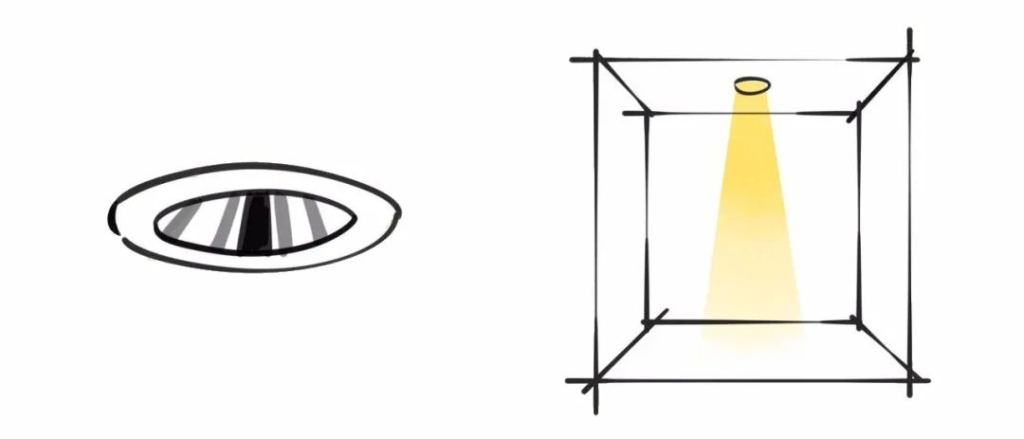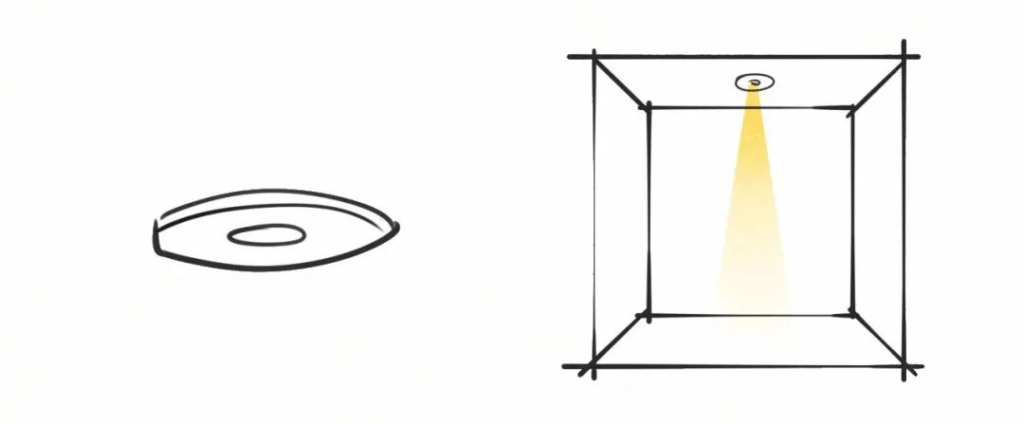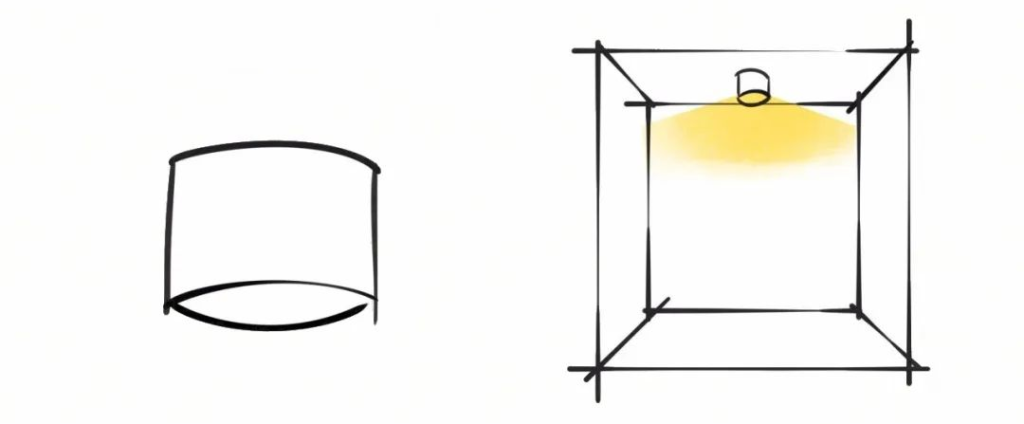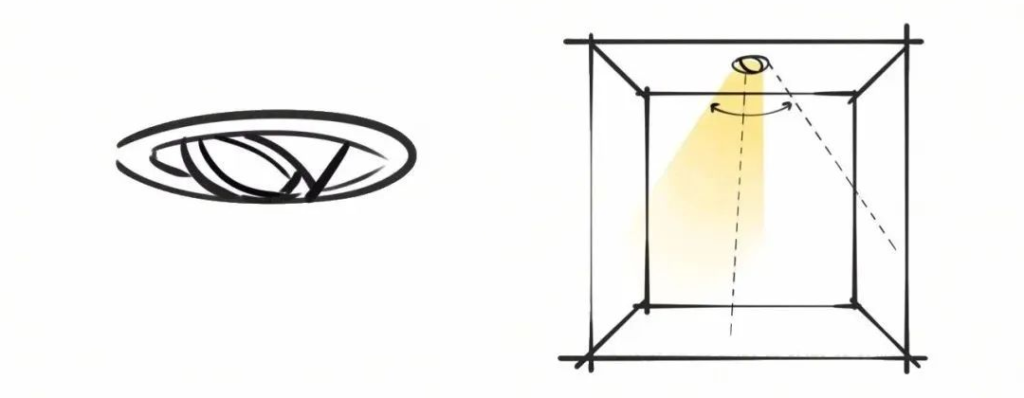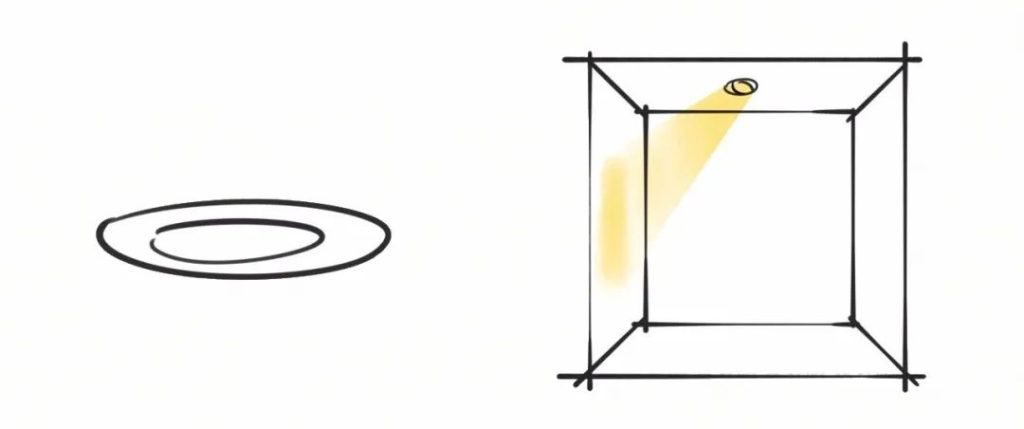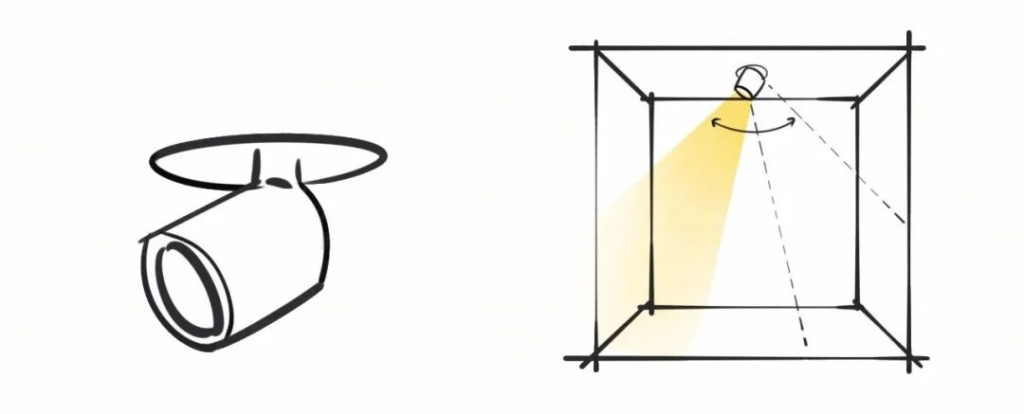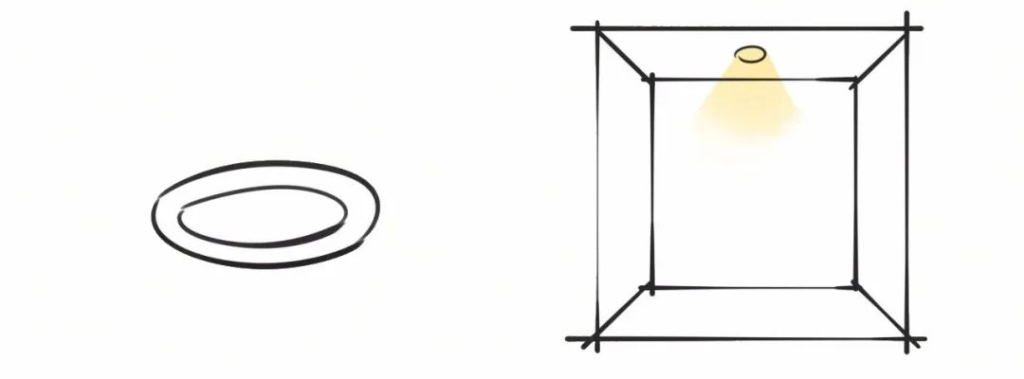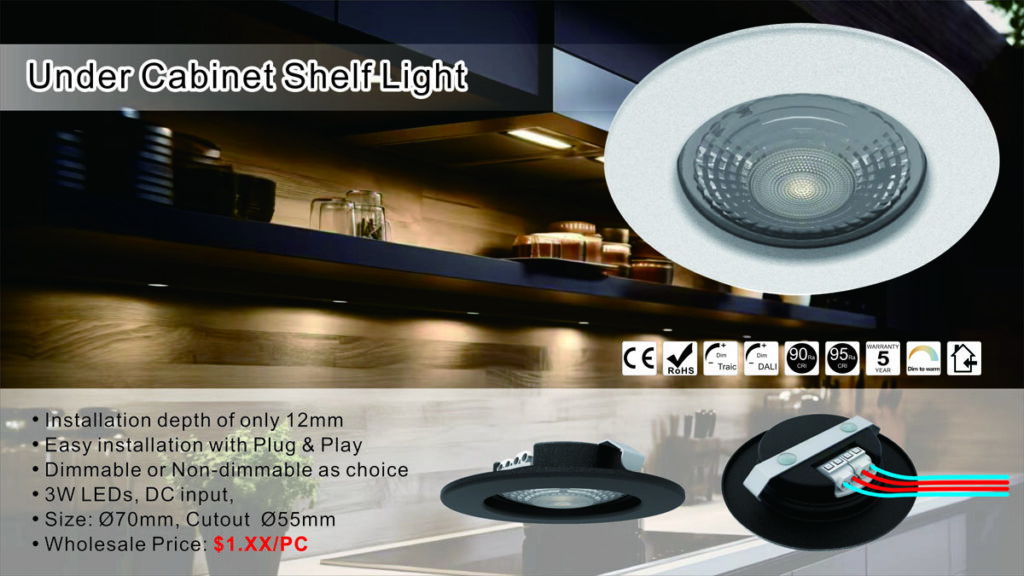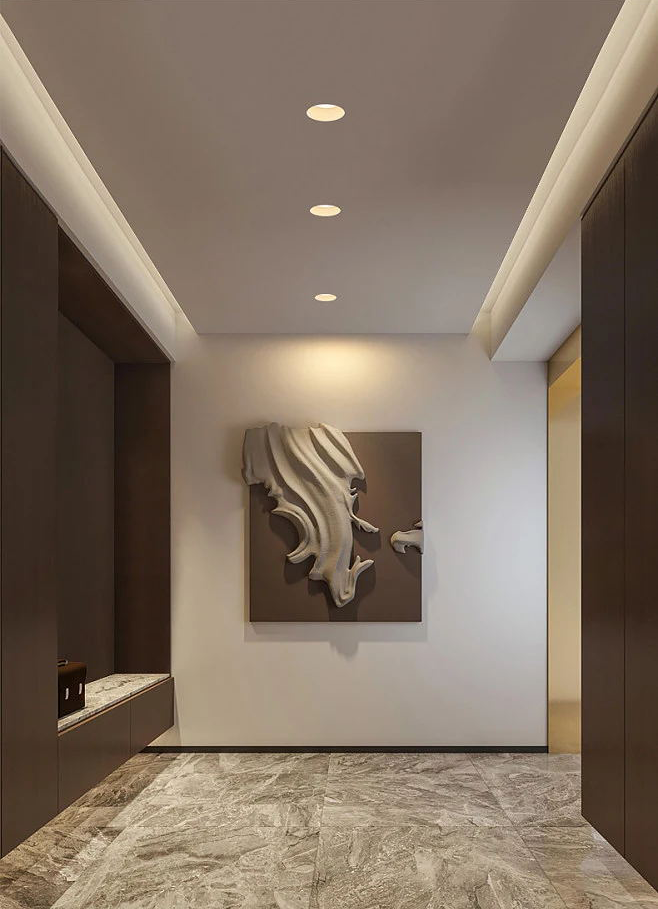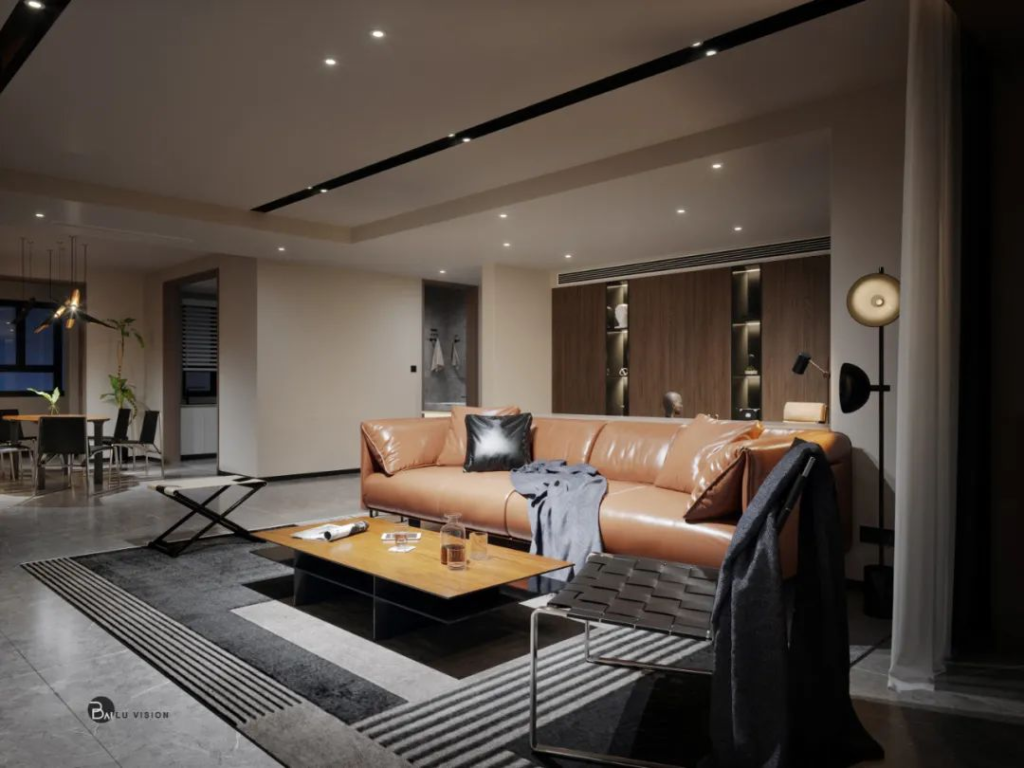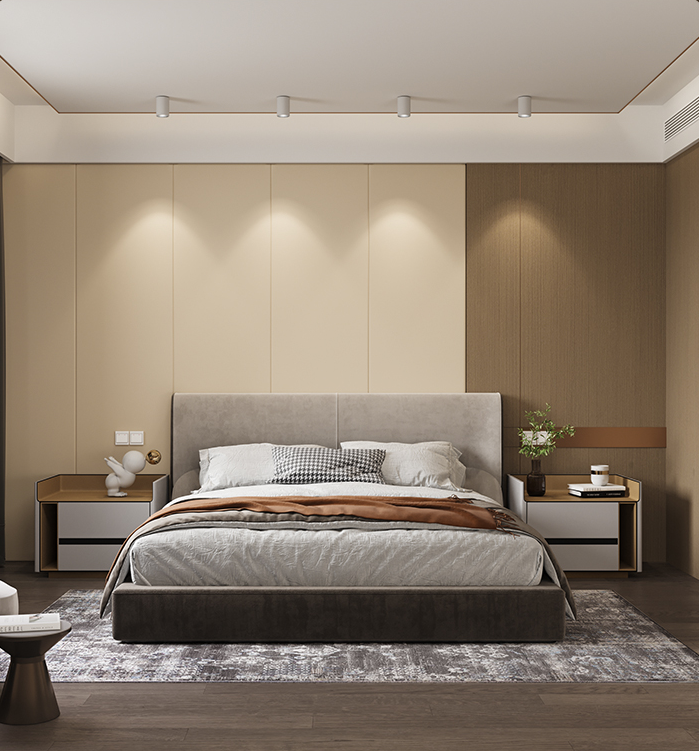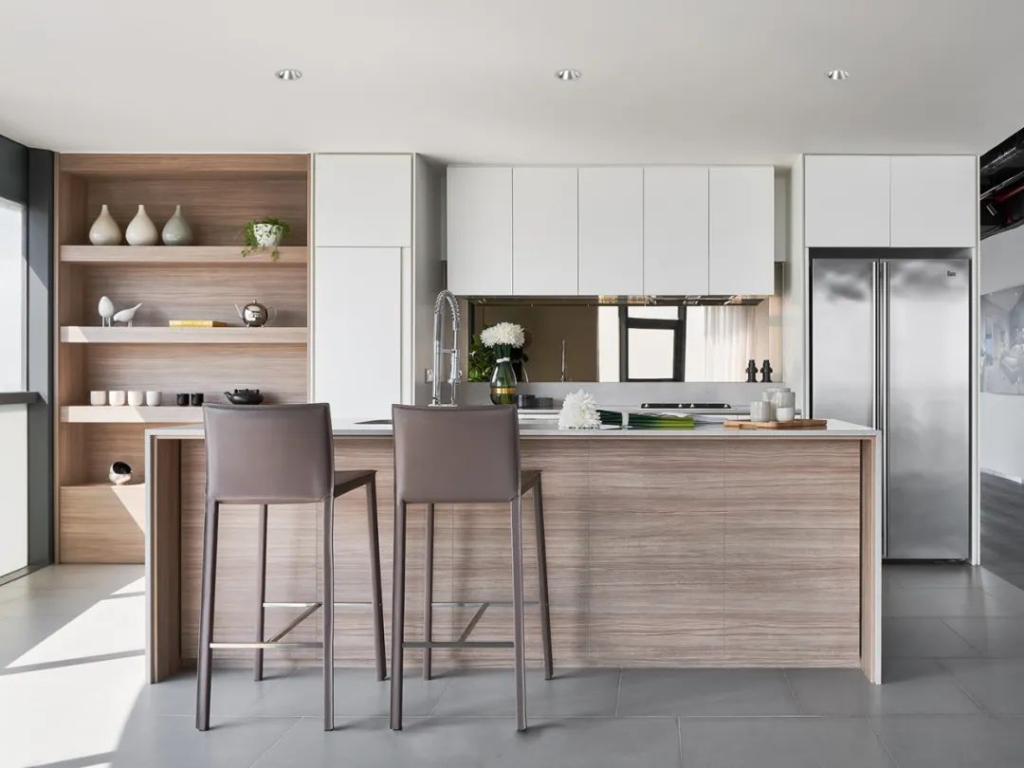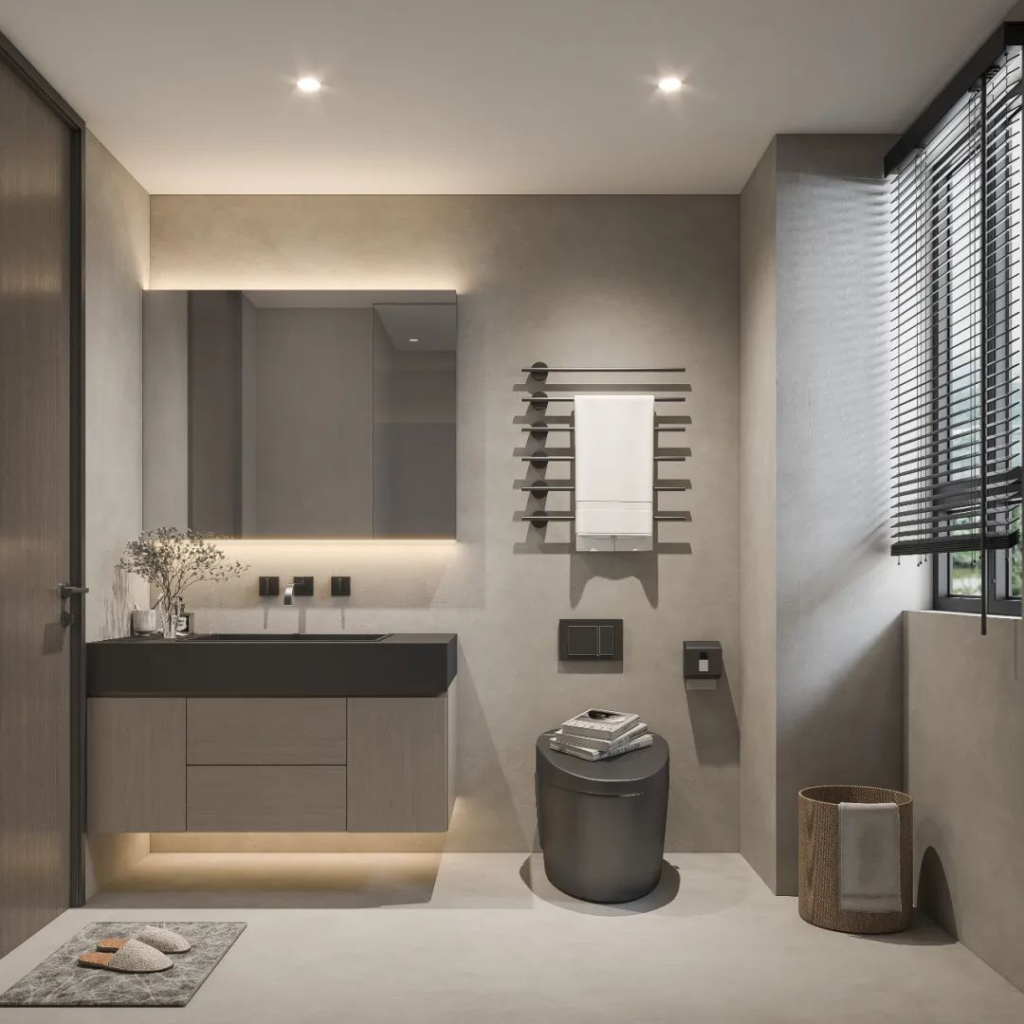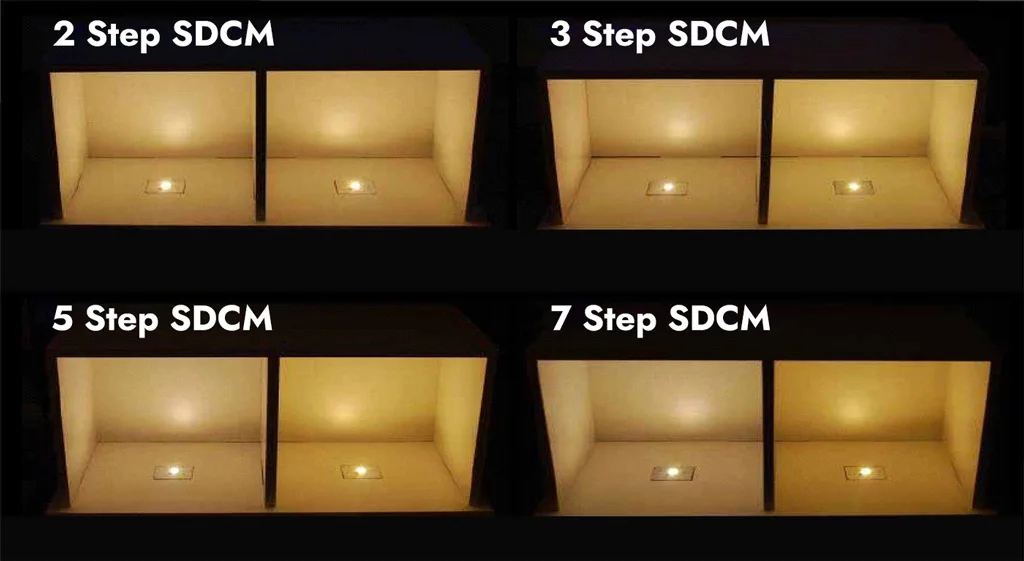When designing no-main light, we often choose downlights, spotlights, and light strips. Among these options, the downlights design plays a crucial role in the overall design. Its light spreads softly, reminiscent of stars scattered across the night sky. The gentle glow it creates is like moonlight touching the earth, producing an ambiance that feels dreamlike. This unique quality sets downlights apart from other lighting fixtures.
In this article, we will focus on downlights and explore their captivating charm in transforming spaces.
What is a Downlight?
A downlight is a cleverly designed lighting fixture known for its even light distribution and wide beam angle. This type of light primarily directs illumination downward, providing direct lighting where it’s needed most. The name “downlight” comes from its cylindrical shape, resembling a small tube or barrel.
There are two main types of downlights available on the market: surface-mounted downlight and recessed downlight.
Surface-mounted downlights are installed in visible locations and are easy to set up. They do not require ceiling modifications, making installation straightforward. Common options include flush-mounted surface downlights that sit close to the ceiling, providing soft illumination. There are also pendant-style surface-mounted downlights and track lights that can be adjusted to create different atmospheres.
Recessed downlights feature an embedded design that allows them to be installed flush with the ceiling. This design requires cutting a hole in the ceiling to hide most of the fixture, leaving only a small light point visible. Compared to standard surface-mounted lights, recessed downlights offer focused lighting and typically have non-adjustable light sources. They can serve as general or accent lighting, creating a warm and inviting atmosphere.
They can serve as general or accent lighting, creating a warm and inviting atmosphere
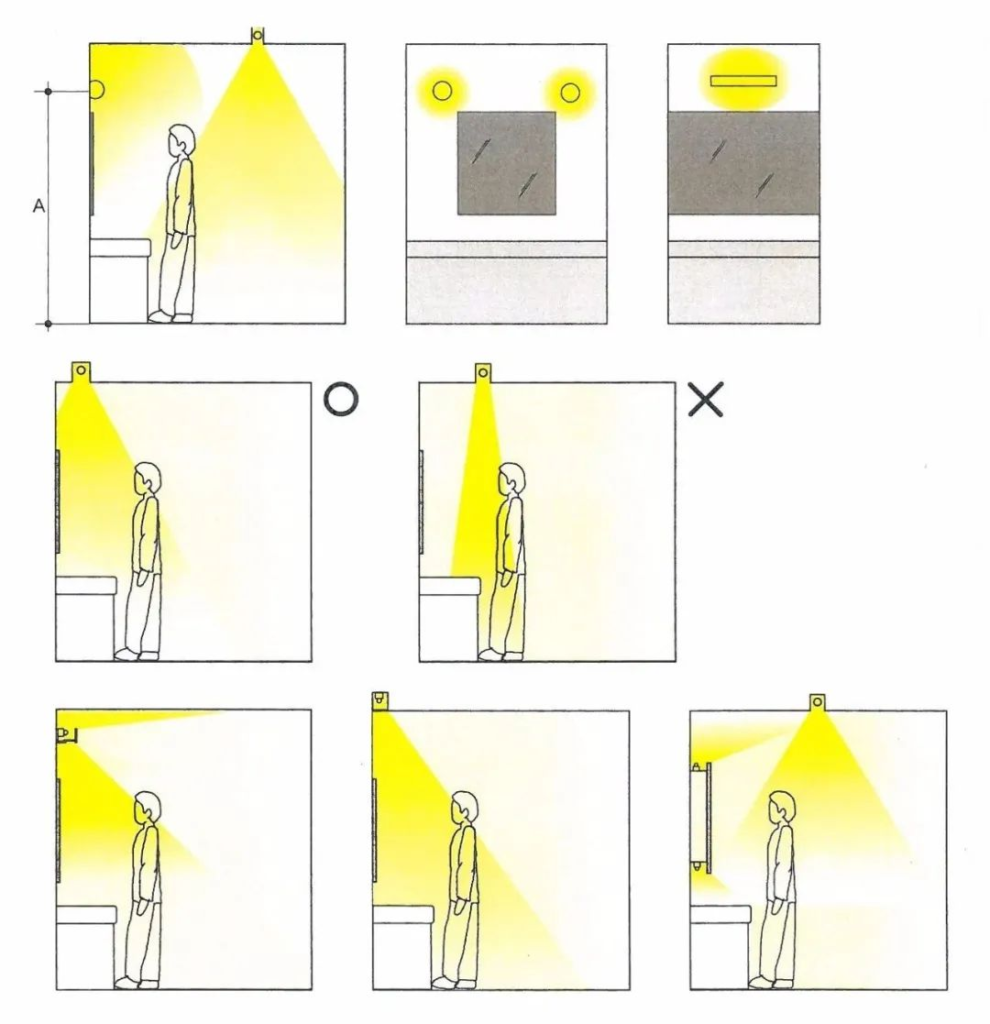
The Lighting Effects of Different Types of Downlights
In designs without a central fixture, downlights serve two primary functions: general lighting and task lighting. By strategically placing multiple light sources, you can achieve comprehensive illumination throughout a space. Alternatively, you can focus on specific areas to highlight key features.
Anti-glare downlights are engineered to significantly reduce the direct visibility of the light source, offering a solution that prioritizes comfort and visual appeal. Traditional downlights often expose the bulb directly, leading to uncomfortable glare. By recessing the light source deep within a specially designed reflector, anti-glare fixtures minimize this effect. This innovative design allows the light to be distributed more evenly and softly, enhancing the overall ambiance of any space. The primary goal is to illuminate the area effectively while ensuring the light source remains discreet, fostering a more comfortable lighting experience.
Key Benefits of Anti-Glare Technology
Adopting anti-glare downlights can result in several tangible improvements to your living or working environment:
- Enhanced Visual Comfort: Reducing the direct visibility of the light source plays a crucial role in preventing eye strain and visual discomfort. This is particularly important in spaces where individuals spend a significant amount of time, such as offices, living rooms, or reading nooks. The softer, more diffused light is gentler on the eyes, promoting a more relaxed and productive atmosphere.
- Improved Aesthetic Appeal: Instead of harsh, direct light, anti-glare downlights emphasize ambient lighting, which contributes to a warmer and more inviting atmosphere. The focus shifts from the fixture itself to the illuminated space, highlighting architectural details and interior design elements. This subtle approach to lighting design creates a sophisticated and visually pleasing environment.
- Versatile Applications: Anti-glare downlights are highly versatile and suitable for a wide range of applications. From residential spaces like kitchens and bedrooms to commercial settings such as retail stores and offices, these fixtures can be seamlessly integrated into any environment. They are also an excellent choice for hospitality settings like hotels and restaurants, where creating a comfortable and inviting atmosphere is paramount.
Diffuser downlight / panel downlight
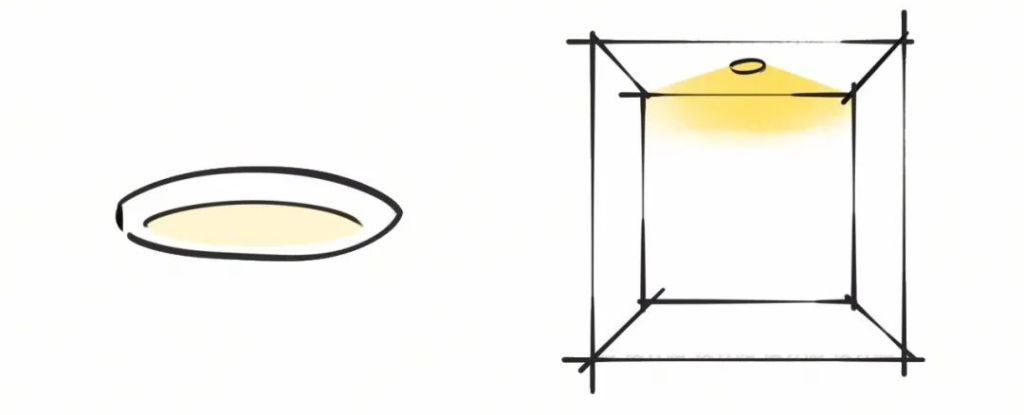
Understanding Diffuser Downlights
Diffuser downlights are designed with a larger luminous angle, which allows them to spread light more evenly across a wide area. This feature makes them particularly effective for large opening spaces such as conference rooms, retail environments, and open-plan offices. By softening the light output, diffuser downlights help to reduce harsh shadows and create a more inviting atmosphere.
The Benefits of Panel Downlights
On the other hand, panel downlights also provide excellent illumination for spacious settings. They feature a sleek design and can be installed in various configurations, allowing for versatile lighting solutions. Panel downlights are often used in modern interiors due to their minimalist aesthetic and ability to deliver uniform light distribution.
Choosing the Right Option for Your Space
When selecting between diffuser downlights and panel downlights, consider the specific lighting needs of your space. If you require broad coverage with minimal glare, diffuser downlights may be your best choice. However, if you prefer a contemporary look with customizable installation options, panel downlights might be more suitable.
An LED spotlight enhances illumination by channeling light through a precisely engineered design. At the lamp’s base, a central aperture is created, while the surrounding area is intentionally blocked. This configuration serves to concentrate the emitted light, resulting in a more focused beam and a minimized irradiation range. By obscuring the direct view of the light source, this design significantly reduces glare, improving visual comfort and reducing eye strain for users. Typically, these lamps are characterized by a narrow beam angle, optimizing them for tasks requiring intense, directed light.
The Importance of Beam Angle in LED Spotlights
The beam angle is a crucial factor in LED spotlight performance. A smaller beam angle means a tighter, more concentrated beam of light. This is ideal for highlighting specific objects or areas, creating dramatic effects, or providing task lighting for activities like reading or detailed work. The carefully calibrated design ensures that the LED spotlight delivers light precisely where it’s needed.
When it comes to lighting solutions, surface-mounted downlights are an excellent choice, especially in spaces where traditional recessed lighting isn’t feasible. These fixtures not only illuminate a room effectively but also enhance its aesthetic appeal. As you consider options for your lighting design, understanding the benefits and applications of surface-mounted downlights will help you make informed decisions.
Why Choose Surface-Mounted Downlights?
Surface-mounted downlights are particularly useful in situations where ceilings do not allow for recessed installations. Here are some key reasons to consider these fixtures:
- Versatile Design Options: Available in various styles, colors, and finishes, surface-mounted downlights can complement any interior decor. Whether you prefer a sleek modern look or a more traditional design, there’s a surface-mounted option to suit your needs.
- Enhanced Light Layering: These fixtures provide an opportunity to create layered lighting in your space. By combining surface-mounted downlights with other light sources such as floor lamps or wall sconces, you can achieve a well-balanced and inviting atmosphere.
- Easy Installation: Unlike recessed lights that require significant ceiling modifications, surface-mounted downlights are easier to install. This makes them an ideal choice for renovations or when working with existing structures.
Tilt downlights and gyro downlights are popular lighting solutions that offer adjustable illumination for various spaces. These fixtures are designed to enhance the aesthetic appeal of a room while providing targeted lighting where it’s needed most.
Key Features of Tilt Downlights
Adjustable Angles: One of the standout features of tilt downlights is their ability to adjust the angle of the light. Typically, these fixtures allow for a tilt range of up to 25 degrees, enabling users to direct light precisely where it is needed. This flexibility makes them ideal for highlighting artwork, architectural details, or specific areas within a room.
Space Considerations: The design of tilt downlights requires careful planning during installation. The light source is positioned at the innermost part of the lamp, which is relatively large. As a result, it’s essential to ensure that there is sufficient space within the ceiling cavity to accommodate these fixtures. Proper spacing not only ensures optimal performance but also prevents potential overheating issues.
Benefits of Gyro Downlights
Gyro downlights take versatility a step further by incorporating a rotating mechanism. This feature allows for 360-degree rotation, making them perfect for dynamic lighting needs. Whether you want to change the ambiance of a room or focus light on different areas throughout the day, gyro downlights provide unparalleled flexibility.
One of the primary advantages of wall washer downlights is their ability to improve the overall aesthetics of a space. These fixtures provide uniform light distribution, accentuating the textures and colors of wall-mounted items. By washing walls with light, they can transform ordinary spaces into visually appealing environments, making them perfect for showcasing artwork, photographs, or decorative elements.
Versatile Applications
Wall washer downlights are incredibly versatile and can be used in various settings:
- Residential Spaces: In homes, these lights can highlight architectural features, create mood lighting in living rooms, or showcase family photos in hallways.
- Commercial Environments: Retail stores and galleries benefit from wall washers as they draw attention to products and artworks, enhancing the shopping experience and encouraging purchases.
- Event Spaces: For weddings or corporate events, wall washer downlights can create an elegant atmosphere by illuminating backdrops or decorative walls.
By integrating wall washer downlights into your interior design scheme, you can elevate your space while ensuring that your favorite pieces are beautifully showcased. These versatile fixtures not only enhance visual appeal but also provide energy-efficient illumination tailored to your specific needs. Whether you’re redesigning your home or upgrading a commercial space, consider wall washer downlights as a key element in creating an inviting and stylish environment.
Semi-recessed track lights are emerging as a top choice for homeowners and businesses seeking adjustable lighting with a modern, streamlined aesthetic. These versatile fixtures provide focused directional light and blend seamlessly into any ceiling, offering a sophisticated alternative to traditional lighting solutions. Unlike fully recessed options, semi-recessed track lights extend slightly from the ceiling, allowing for greater flexibility in adjusting the light’s direction. With an angular range typically capped at 90°, they offer precise control over illumination, making them perfect for highlighting artwork, architectural details, or product displays.
Understanding the Advantages of Semi-Recessed Track Lighting
- Flexible Directional Lighting: One of the primary benefits is the ability to easily adjust the light direction. This allows users to adapt the lighting scheme as their needs change, whether highlighting a new piece of art or focusing on a specific workspace.
- Sleek, Integrated Design: The lamp body is designed to integrate smoothly with the ceiling surface, creating a clean, unobtrusive look. This is especially appealing in contemporary spaces where minimalism is valued.
- Precise Illumination: Unlike ambient lighting that diffuses light across a room, semi-recessed lights offer targeted illumination. This makes them ideal for accentuating specific areas or objects, adding depth and dimension to a space.
- Energy Efficiency: Many track lighting systems now incorporate LED bulbs, which are significantly more energy-efficient than traditional incandescent or halogen options. This can result in lower electricity bills and a reduced carbon footprint.
Under cabinet downlights offer a sleek and efficient lighting solution, typically installed at the top of niches or within cabinets. This placement provides focused illumination without demanding significant internal surface depth. A transformer is required to operate these lights due to their unique electrical characteristics.
Understanding Under Cabinet Downlight Applications
Under cabinet lighting is ideal for a variety of applications, including:
- Kitchen Cabinets: Enhancing visibility on countertops for food preparation.
- Display Niches: Highlighting decorative items or artwork in recessed areas.
- Bookshelves: Providing focused light for reading or showcasing book collections.
- Workspace Illumination: Creating a well-lit area under cabinets in offices or workshops.
These versatile lighting solutions serve both functional and aesthetic purposes.
Under cabinet downlights are a versatile and practical lighting choice for various applications. By understanding their benefits, considering the key factors when choosing a model, and following proper installation procedures, you can enhance the functionality and aesthetic appeal of your space.
Task Lighting with Downlights
When used for general lighting, downlights provide uniform brightness across the room, ensuring no area feels dark or neglected.
For task lighting, downlights can spotlight specific areas such as workspaces or reading nooks, enhancing functionality while maintaining aesthetic appeal.
The Layout and Lighting Effects of Downlights
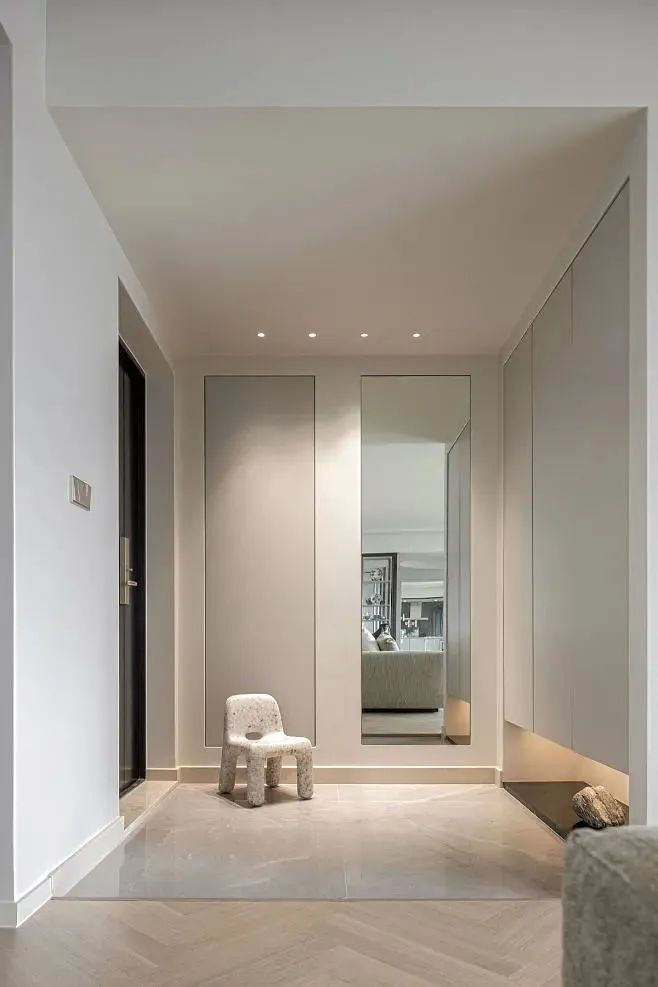
Despite their simple design, downlights reveal unique charm in different environments when properly placed. When positioned thoughtfully, they blend seamlessly into their surroundings and create stunning light and shadow effects. At this point, downlights become more than just lighting tools; they transform into essential elements that shape and guide the atmosphere of a space.
In entryways, a common lighting arrangement involves centering lights at equal distances or starting from corners and circling the space. This layout maintains harmony and distributes light evenly. The result is a welcoming gradient of light and shadow for guests.
Key points for optimizing entryway lighting:
- Even Light Distribution: Centering lights or arranging them in a circle from the corners ensures consistent illumination.
- Harmonious Design: Balanced lighting arrangements create a welcoming and aesthetically pleasing entryway.
- Welcoming Ambiance: A gradient of light and shadow provides a warm reception for guests.
Downlights offer a subtle yet impactful way to enhance the ambiance of living rooms. Often integrated seamlessly into ceilings or discreetly positioned behind furniture, these fixtures serve as silent partners in shaping the overall atmosphere of your space. The gentle, diffused illumination they provide works in harmony with your main lamps, achieving a delicate balance that significantly elevates the aesthetic appeal of the room.
Understanding the Power of Downlight Placement
Effective downlight placement is key to maximizing their potential. Rather than simply scattering them across the ceiling, consider these strategic approaches:
- Highlight Architectural Features: Use downlights to accentuate unique aspects of your living room, such as a fireplace, artwork, or a decorative molding. Directing light onto these elements draws attention and adds depth to the space.
- Create Zones of Illumination: Define different areas within your living room by using downlights to create pools of light. For example, focus lighting over a reading nook or a conversation area to create a sense of intimacy and purpose.
- Layered Lighting Approach: Downlights should not be the sole source of light in your living room. Combine them with other lighting fixtures like floor lamps, table lamps, and accent lights to create a layered lighting scheme. This allows you to adjust the overall brightness and mood of the room to suit different activities and times of day.
Bedroom design hinges on creating a relaxing and inviting space, and lighting plays a pivotal role. Creative bedroom lighting layouts often incorporate LED downlights in strategic arrangements, such as circular matrices that emulate the serene beauty of a starlit night sky. The spacing of these fixtures is crucial: precisely placed to avoid harsh glare or pools of shadow, achieving a gentle, warm, and romantic ambiance perfect for unwinding.
Enhancing Ambiance with Layered Lighting
To elevate the atmospheric effect, consider integrating hidden LED strip lighting. Positioned strategically around the perimeter of the room or within architectural features, these strips reflect soft, diffused light, creating layered halos reminiscent of moonlight shimmering on water. This combination of focused downlighting and subtle LED accents adds depth and sophistication, transforming the bedroom’s ambiance into a tranquil retreat.
Selecting the Right Downlights for Your Bedroom
Choosing the right downlights involves considering several factors.
- Brightness and Color Temperature: Opt for warm white LEDs (around 2700-3000K) to promote relaxation. Dimmable downlights offer flexibility to adjust the intensity based on the time of day or your mood.
- Energy Efficiency: LED downlights are significantly more energy-efficient than traditional incandescent or halogen bulbs, reducing electricity consumption and saving money. Look for models with high Energy ratings.
- Size and Style: Select downlights that complement the overall design aesthetic of your bedroom. Recessed downlights offer a clean, minimalist look, while surface-mounted options can add a decorative touch.
Smart Lighting Systems for Ultimate Control
Integrating smart lighting systems allows for even greater control over your bedroom’s ambiance. These systems enable you to adjust brightness, color temperature, and even create custom lighting scenes with a smartphone or voice command. Scheduling features can automatically dim the lights as bedtime approaches, promoting better sleep hygiene.
The Impact of Lighting on Sleep Quality
The type and intensity of bedroom lighting can significantly impact sleep quality. Blue light emitted from electronic devices and some LEDs can suppress melatonin production, making it harder to fall asleep. Warm-toned LEDs with adjustable brightness levels are ideal for creating a relaxing pre-sleep environment.
Effective kitchen lighting hinges on strategic downlight placement, impacting both functionality and the overall aesthetic appeal. Whether downlights take center stage as a primary lighting source or act as supporting accents dictates the ambiance and usability of your kitchen. Consider the room’s size and layout when planning. Open-concept kitchens often allow for more flexible and creative lighting designs, while galley or narrow kitchens may benefit from the streamlined look of straight-line downlight arrangements.
Considerations for Optimal Downlight Layout
Choosing between concentrated or dispersed downlight layouts depends on several factors:
- Kitchen Size and Shape: Larger kitchens can accommodate more dispersed lighting, creating a uniform glow. Smaller kitchens may benefit from focused lighting to highlight key areas.
- Task Lighting Needs: Position downlights directly above work surfaces like countertops, islands, and sinks to ensure adequate task lighting for food preparation.
- Ambient Lighting Goals: Create a warm and inviting atmosphere by layering light. Combine downlights with other light sources like pendant lights and under-cabinet lighting.
Regardless of the chosen arrangement, downlights can beautifully illuminate kitchens, creating layers of balanced and pleasant light. Thoughtful kitchen downlight planning enhances the space’s functionality and aesthetic value, making it a welcoming and efficient area for cooking and gathering.
In bathrooms, downlights shine elegantly as primary fixtures. They can cluster at the ceiling or scatter throughout corners based on ceiling design. However, it’s essential to implement waterproof measures due to high humidity levels in bathrooms to ensure longevity.
Downlights play roles beyond mere illumination; they act as artistic pieces that enhance aesthetics. Regardless of their form, they create captivating layers of light that infuse spaces with unique charm.
Choosing the right downlights for bathrooms requires careful consideration of both light distribution and safety. Light distribution affects the overall ambiance and functionality of the space, while waterproofness is paramount for preventing electrical hazards in a moisture-rich environment. Prioritizing waterproof lamps is non-negotiable when it comes to bathroom lighting.
Understanding IP Ratings for Bathroom Safety
The Ingress Protection (IP) rating indicates a lamp’s resistance to water and solid objects. For bathrooms, it is recommended to install fixtures with a minimum rating of IP44. This provides protection against water splashing from any direction. However, for areas directly exposed to water, such as above a shower or bathtub, IP65 rated downlights offer a higher level of protection against water jets. Investing in IP65 waterproof downlights ensures longevity and safety, providing peace of mind. Click HERE to know more lighting safety regulations for bathroom.
Balancing Light Distribution and Safety
Beyond waterproofness, consider the type of light distribution required for your bathroom. Different downlights offer various beam angles and intensities, affecting how light is spread throughout the room. Plan the placement and type of bathroom downlights to achieve adequate illumination without compromising safety. Selecting downlights with suitable IP ratings ensures the safety and longevity of your bathroom lighting system.

Radians: Your Premier LED Downlight Manufacturer
Radians specializes in the manufacturing of LED downlights, including LED dimming downlights, anti-glare downlights, waterproof downlights, and smart downlights. Our product line also features panel lights and track lights. We combine professional design and engineering to rigorously test and innovate our LED lighting solutions.
Exclusive Design Services and Regional Partnerships
Our dedicated sales and R&D teams offer comprehensive support, from initial product development and design to final product realization. We empower our partners with regional exclusivity, allowing you to offer unique designs that differentiate you from competitors in the LED downlight market.
Unwavering Quality and Comprehensive Warranty
Radians is committed to product excellence. We maintain strict quality control throughout our supply chain, from raw materials and warehousing to production and final quality inspection. Most of our products are backed by a 5-year warranty and professional after-sales service, ensuring your satisfaction and peace of mind. We are a responsible LED lighting provider focused on quality.
Conclusion
Downlights are versatile lighting solutions that enhance both functionality and aesthetics in various settings. Their ability to create beautiful effects through thoughtful placement makes them invaluable in modern interior design. Whether illuminating an entryway or adding warmth to a bedroom, these downlights design bring spaces to life with their enchanting glow.
FAQs
Are downlights energy-efficient?
Yes, especially LED downlights, which consume significantly less energy than traditional bulbs.
Can downlights be used in any room?
Yes, their versatility makes them suitable for various spaces, including kitchens, living rooms, and offices.
Do downlights require special installation?
Professional installation is recommended to ensure safety and proper functionality.
How long do LED downlights last?
LED downlights can last up to 50,000 hours, significantly longer than incandescent bulbs.

